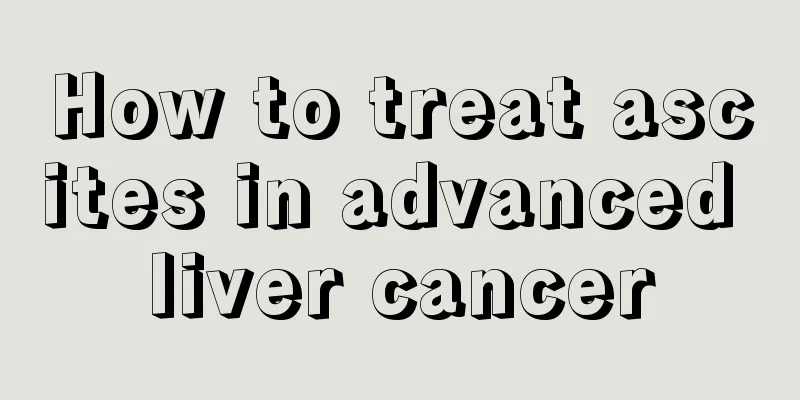How to treat ascites in advanced liver cancer

|
Ascites treatment is actually a treatment method for advanced liver cancer. When choosing a treatment method, the doctor will base it on the patient's physical condition. The ascites treatment method can also have good therapeutic effects, and it can be combined with traditional Chinese medicine if necessary. Controlling the primary lesion is the key to treating ascites caused by liver cancer. When treating ascites, attention should be paid to the treatment of the primary liver cancer. Only simultaneous treatment can inhibit the regeneration of accumulated water. The first focus should be on draining the ascites. By draining ascites, the patient's symptoms can be quickly improved, but it is easy to relapse and the treatment is not complete. Clinically, while draining ascites, some addictive drugs, such as anticancer drugs, sclerosants, immunomodulators, etc., are infused into the chest cavity to directly kill cancer cells and slow down the production of ascites in liver cancer. However, the treatment effect of this type of liver cancer ascites is poor, and it will bring great toxic side effects to patients, and it only treats the symptoms but not the root cause. Therefore, clinical practice often advocates a combined treatment plan of combined surgery, chemotherapy or autologous immune cell therapy. 1. Ascites reinfusion therapy: For the late stage of ascites in cirrhosis, special devices are used to extract the ascites, process and concentrate it, and then infuse it into the patient. The advantage is that it overcomes the situation of protein loss caused by simply draining the peritoneum. The disadvantage is that the late-stage symptoms of ascites in cirrhosis will lead to multiple abdominal punctures, increasing the chance of infection and making bacterial peritonitis more likely to occur. Treatment of small amount of ascites: In the late stage of ascites due to cirrhosis, pay attention to bed rest and low-salt diet. For patients with late-stage ascites due to cirrhosis, water intake should be appropriately limited (approximately 1 to 1.5 L per day). Proper nutrition should be maintained, liver protection treatment should be strengthened, liver function, kidney function and blood electrolytes should be checked regularly, and for those with hypoproteinemia, appropriate amounts of albumin and plasma should be supplemented to eliminate some of the ascites. 2. Drug treatment for late-stage ascites: For patients with late-stage ascites due to cirrhosis who have not responded to measures such as rest and salt restriction, consideration should be given to the use of a combination of Chinese and Western medicine for treatment. In Western medicine treatment, it can promote the excretion of water and sodium, reduce ascites, inhibit the kidney's absorption of sodium and chloride, and excrete potassium at the same time. At present, in the treatment of ascites in late-stage liver cirrhosis, it is advocated to use a combination of Chinese and Western medicine and internal conditioning treatment to fundamentally eliminate the inducing factors of ascites, thereby playing a comprehensive prevention and treatment role. This is very beneficial to the long-term efficacy of ascites, and also greatly reduces the recurrence rate of ascites. |
<<: Is it easy for ichthyosis vulgaris to relapse after treatment?
Recommend
Which brand of lutein is good
Lutein is mostly found in vegetables. In daily li...
Can snake oil cure acne?
Snake oil is made by extracting fat from snakes. ...
Does ovarian teratoma affect pregnancy? 3 factors that affect pregnancy
Ovarian teratoma is a relatively common tumor of ...
Is glutamyl transpeptidase 146 considered high?
In daily life, many people often have irregular d...
There are small red spots on my arms that look like blood spots
Capillaries are distributed in every part of our ...
What's wrong with the pain under my chin?
The human body works like this, when one part mov...
Fruits for sore throat
The throat is an important organ of the human bod...
How long does it take for the side effects of ultrasonic knife to appear
Nowadays, beauty salons can perform more and more...
Inflammation of wound after fracture surgery
There are always many accidents that happen to ev...
Symptoms after intervention
In our lives, many patients with serious illnesse...
What nutrients does the human body need
What nutrients does the human body need? This que...
What is the hard thing I feel on my left lower abdomen?
The left lower abdomen refers to the lower left p...
What are the causes of prostate cancer in the elderly
Prostate cancer is a malignant tumor that poses a...
If the adult 375 does not subside for a long time, is it inflammation?
Many people have experienced colds and fevers, wh...
What adverse reactions are common in patients with lung cancer undergoing chemotherapy? 5 dietary tips after radiotherapy for lung cancer
With the continuous improvement of medical techno...









